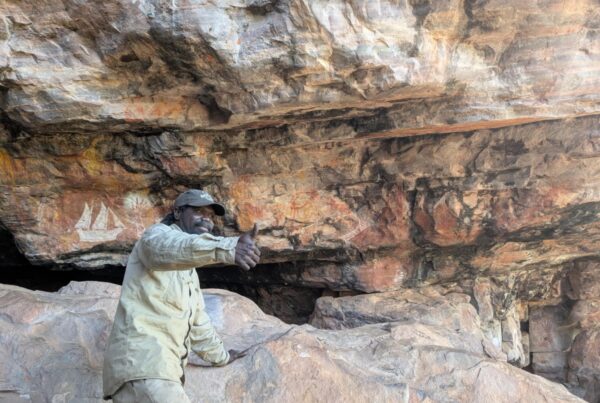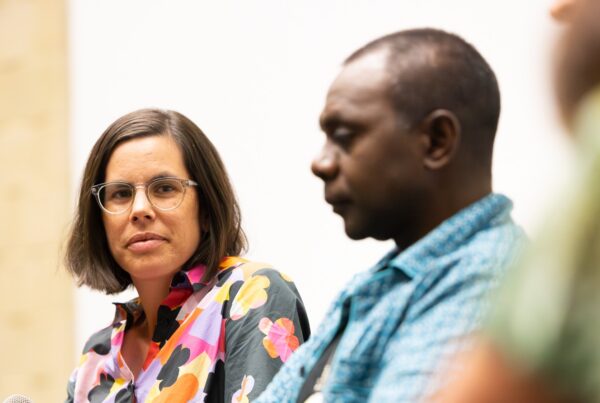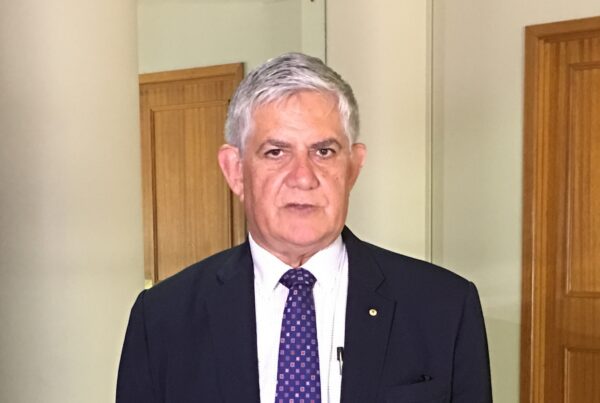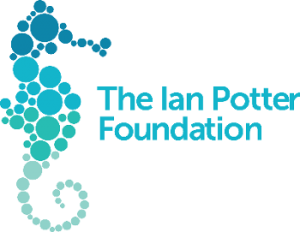Ubirr – View from protected shelter towards the main escarpment Bunidj, Manilakarr and Mandjurlgunj caretakers Kakadu National Park (established 1979). Photograph: George Chaloupka, September 1973. Digitised courtesy of Rock Art Australia
Welcome to the Autumn Edition of Rock Art Australia’s e-News
As we step into the winter season and reflect on the past three months, I am proud to share the powerful momentum Rock Art Australia has built across research, partnerships, fundraising and public engagement.
This has been a season of meaningful progress. With energy, clarity and purpose, our team has delivered on critical goals, supporting pioneering research initiatives, deepening relationships with Aboriginal communities and partners, expanding our donor and corporate networks, and increasing national engagement with our work. At the same time, we are laying the groundwork for long-term sustainability through strategic planning and organisational development.
At Rock Art Australia, we are committed to uncovering and protecting one of the world’s greatest cultural and scientific legacies. As we approach the end of the financial year, I warmly invite you to support the leading-edge work of Australian scientists in collaboration with Aboriginal communities and Traditional Owners. Together, we are revealing Australia’s deep past through the interplay of time, geology, geography and cultural tradition, held within remarkable rock art.
Latest Updates
In this edition, we are delighted to welcome the newest member of our Science Advisory Council, Donny Imberlong. Donny is a Jaru man from the East Kimberley who brings a powerful combination of lived cultural knowledge and scientific insight. His involvement exemplifies the strength of two-way knowledge exchange that sits at the heart of our work.
We also share exciting updates from across the Rock Art Australia community, including:
- Cutting-edge research identifying chemical markers in traditional plant adhesives
- Insights from an international conference advancing rock art dating techniques
- Inquiries into how First Australians responded to environmental shifts over millennia in Western Arnhem Land
- The creation of a user-friendly database that enables Aboriginal heritage sites to be mapped, monitored and preserved with cutting-edge tools
- Revealing over 13,000 years of cultural history including the discovery of extinct species and ancient finger markings in Gippsland
- A new outreach initiative in the Kimberley, inspiring local high school students
- Vital conservation and digitisation work preserving cultural heritage for future generations
- The outcomes of digitising a rock art archive to safeguard cultural and scientific knowledge for current and future generations
In addition, you will find links to new peer-reviewed research publications, and updates on upcoming Rock Art Australia events and opportunities to engage.
This newsletter also celebrates the success of our national lecture series Two Ways to See: A Rock Art Research Journey. After 12 months of sharing knowledge with audiences in capital cities around the country, co-presenters Ian Waina and Professor Andy Gleadow reflect on the transformative Kimberley Rock Art Dating project, the collaborative book it inspired, and the future of two-way research.
End of Financial Year Appeal: Join us in telling Australia’s story
This end of financial year, we invite you to be part of a shared national mission to tell the complete story of Australia’s deep past. This requires nationwide research and your tax-deductible donation will directly support:
- Two-way knowledge partnerships between Aboriginal communities and multidisciplinary research teams
- Critical scientific research that fills enduring gaps in Australia’s cultural, biological and environmental history
- Public engagement and education, translating our discoveries into school curricula, books, films, exhibitions and lectures
- A stronger, more unified national identity, grounded in truth, knowledge, and pride in the achievements and cultural richness of the first Australians.
Our research tells a story that belongs to every Australian. It is a story of resilience, ingenuity and connection to land, written in pigment and stone. With your support we can continue to preserve, protect and share this extraordinary legacy.
Please consider making a tax-deductible donation before June 30, 2025.
Best wishes,
Dr Samantha Hamilton. CEO
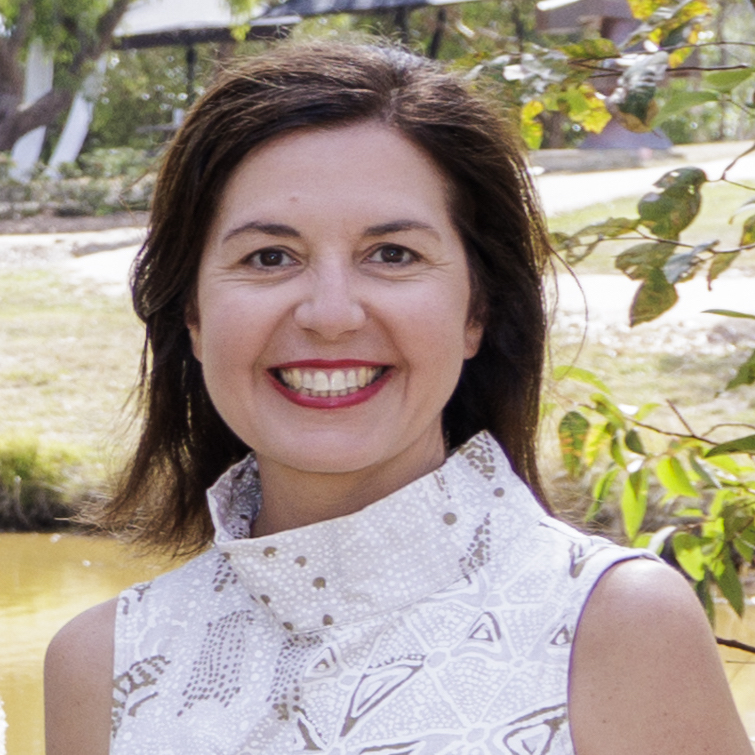
Welcome Donny Imberlong
From Dr Helen Green, Science Advisory Council Chair
I’m delighted to warmly welcome Donny Imberlong to the Rock Art Australia Science Advisory Council.
Donny is a Jaru man from the East Kimberley and brings a wealth of knowledge, lived experience, and a strong connection to the region. With a background in Indigenous and Environmental Studies (University of Melbourne and UWA), he also brings strong academic insight and experience working alongside researchers from the Rock Art Dating and Kimberley Visions projects.
A passionate science communicator, Donny has hosted a weekly radio program on conservation issues and shares engaging content with a broad audience through social media (@DonnyDrysdale)-helping to make complex environmental and cultural topics more accessible.
We’re thrilled to have Donny joining the SAC and look forward to the perspectives and expertise he will contribute. Please join me in warmly welcoming Donny to the SAC.

From the Rock Art Australia Minderoo Chair in Archaeological Science, Rachael Popelka-Filcoff
Visiting PhD Researcher Sophia Vogelsang at the Archaeological Science Laboratory
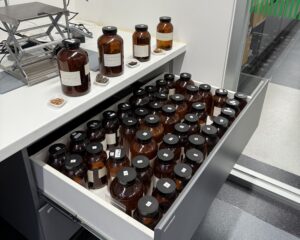
Historic collection of century-old Australian plant exudates

Sophia working in the Archaeological Science Laboratory
From February to April 2025, Sophia Vogelsang, a jointly supervised PhD student at the University of Wisconsin-Madison, USA was a visiting researcher in the Archaeological Science Laboratory at the University of Melbourne. Her innovative research examines Australian plant exudates (resins, kinos and gums), used by Indigenous Australians for thousands of years as adhesives and paint binders. Her work contributes to the ARC Linkage Project ‘From the Desert to the Sea’, a collaboration with the University of Western Australia, Murujuga Aboriginal Corporation (MAC), Mungarlu Ngurrarankatja Rirraunkaja Aboriginal Corporation RNTBC (MNR), Jamukurnu Yapalikurnu Aboriginal Corporation (JYAC), and the Western Australian Museum. For her research in the Archaeological Science Laboratory, Sophia utilised pyrolysis gas chromatography mass spectrometry (py-GC-MS) at TraCEES to find chemical markers in century-old and modern plant exudates. She characterized over 50 exudate samples with py-GC-MS, probing distinctions between different plant genera and aging-related chemical changes in pairs of aged and modern Callitris, Araucaria, Eucalyptus, and Xanthorrhoea samples. Through the Desert to Sea collaboration, she also characterised Spinifex (Triodia) resin in a set of artifacts from the Western Australia Museum, including spear throwers and resin cakes.
These results, alongside complementary techniques Fourier transform infrared spectroscopy (FTIR), X-ray Raman scattering (XRS), and nuclear magnetic resonance (NMR), can be used to explore chemical differences between exudates on artifacts, such as heating or aging. Combining these analyses with Indigenous knowledge will further our understanding of the fundamental chemistry, aging behaviour, and usage of culturally important native Australian plant exudates in the archaeological past and across time.
From RAA’s Science Advisory Council Chair Dr Helen Green
Rock Art Australia Researchers present on the challenges of dating rock art at the Society for American Archaeology’s 90th annual meeting in Denver, Colorado.
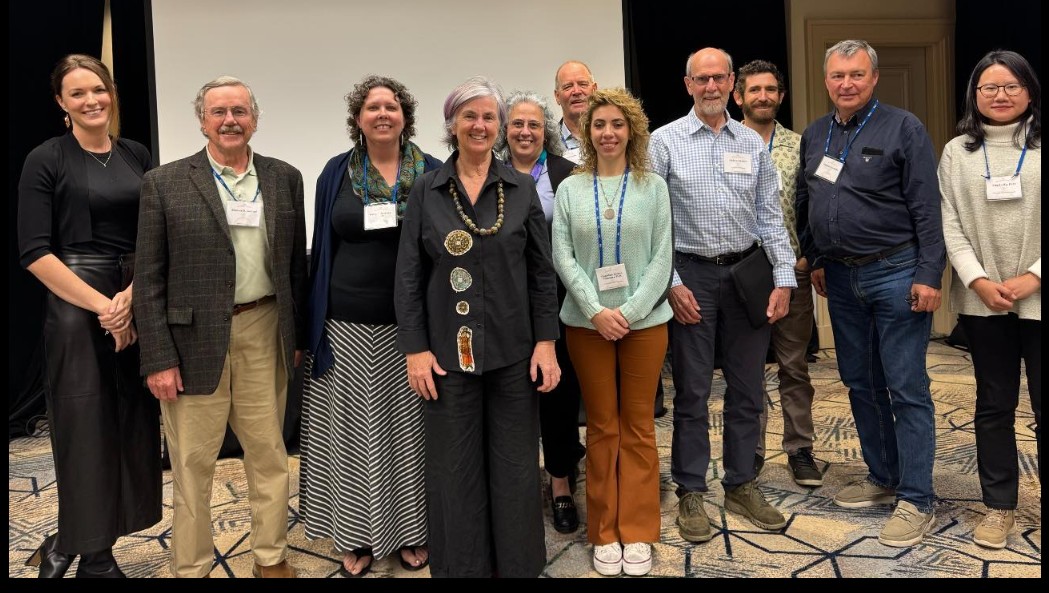
Presenters from left to right: Dr Helen Green (University of Melbourne), Meinrat Andreae (Max Planck Institute for Chemistry), Prof Karen Steelman (University of Central Arkansas), Prof Jo MacDonald (University of Western Australia), Ruth Ann Armitage (Eastern Michigan University), Dr Damien Finch (University of Melbourne), Guadalupe Romero Villanueva (CONICET-National Council for Scientific and Technical Research, Argentina & INAPL-National Institute of Anthropology and Latin American Thought), Prof Andy Gleadow (University of Melbourne), Dr Luke Gliganic (University of Wollongong/Vicus), Dr Vlad Levchencko (ANSTO-Australia’s Nuclear Science and Technology Organisation), Dr Yi-Ling Wu (University of Western Australia)
In April 2025, Dr Helen Greene, and Professors Andy Gleadow and Damien Finch, travelled to Denver, (with Dr Tristen Jones presenting remotely) to attend the 90th Society for American Archaeology Conference in Colorado, invited by Professors Jo McDonald and Karen Steelman, who were convening a session focused on rock art dating. It was a great opportunity to connect with both local and international colleagues, learn about rock art research from around the world, including collaborative projects with Native American communities, and to showcase the work being done across Australia, some of which has been supported by RAA.
The session titled ‘New approaches to the intractable problem of dating rock art’ featured recent advances being made around the world in direct, indirect, and contextual dating of pictographs, petroglyphs, and other forms of human rock markings. Pictographs in caves or on rock shelter walls and petroglyphs in various outdoor settings have the potential to provide remarkable insights into the visual worlds of early human cultures globally. Extraordinary developments in various scientific fields have enabled researchers to progress age estimations for the earliest human art-making. The ability to understand non-destructively pigment use in symbolic behaviours also engages contemporary community interest. Scientific innovation necessitates collaborative approaches to ensure these highly technical methods are deployed in culturally appropriate and methodologically rigorous ways. Advances in scientific methods are often presented in the absence of theory, meaning that these new, especially old dates, create debate in the public domain rather than through scientific due process. The session’s aim was to highlight the scientific advances being made in understanding deep-time and more recent symbolic behaviours across the planet and provide a forum for debating how science must align itself with theoretically grounded archaeological interpretations as well as Indigenous perspectives.
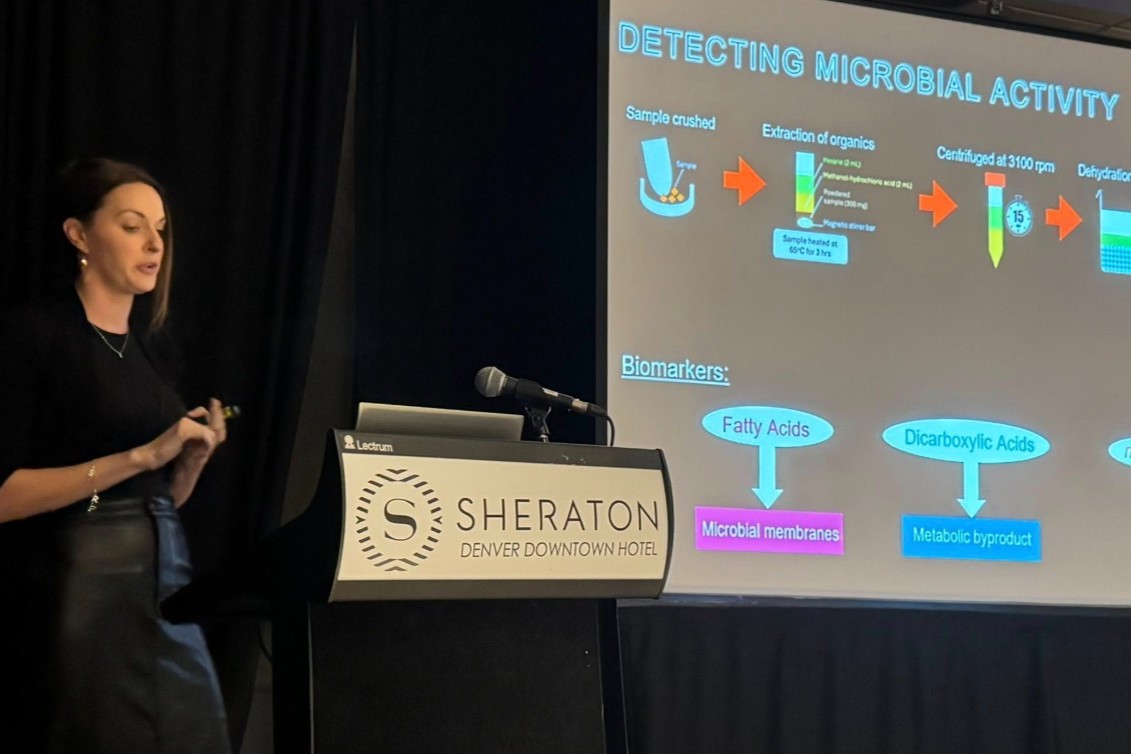
Dr Helen Green
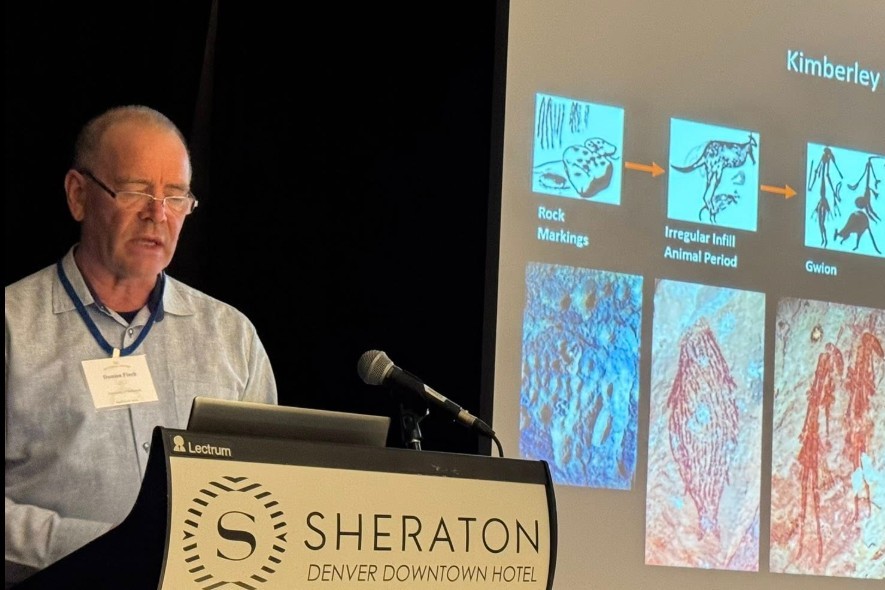
Dr Damien Finch
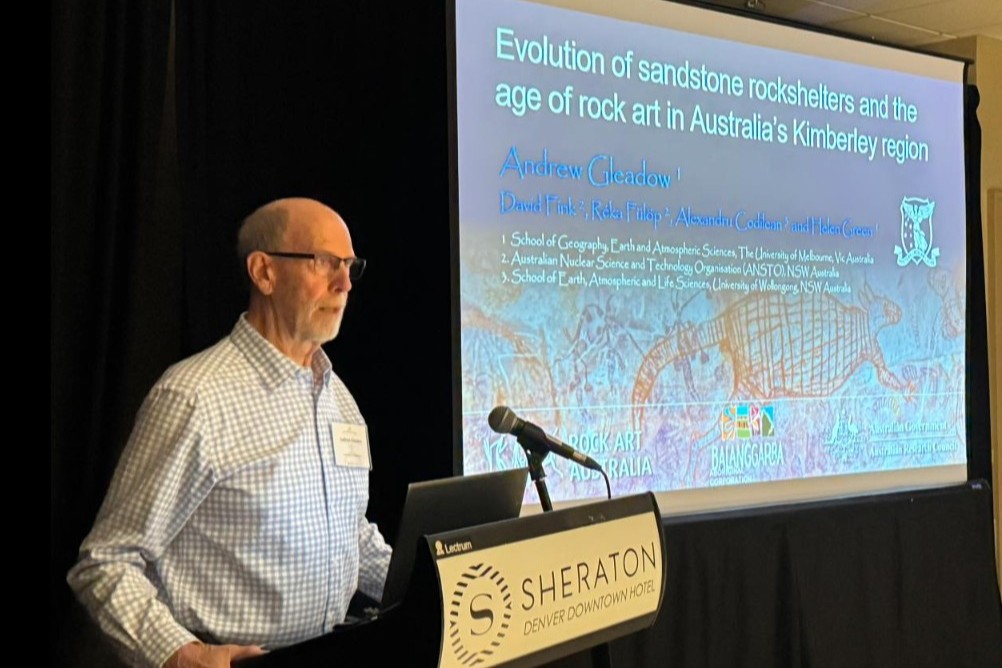
Prof Andy Gleadow
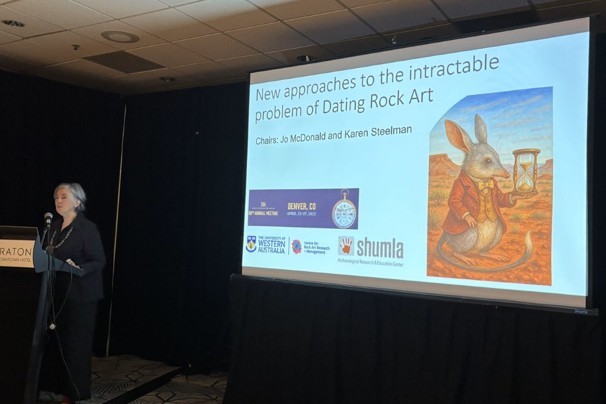
Prof Jo MacDonald
RAA Funded Research Project Update
Rock Art, Archaeology, and Climate Change at Wulk (Red Lily Lagoon), Manilakarr Clan Estate, Western Arnhem Land
Investigating connections between ancient rock art, environmental shifts, and human adaptation.
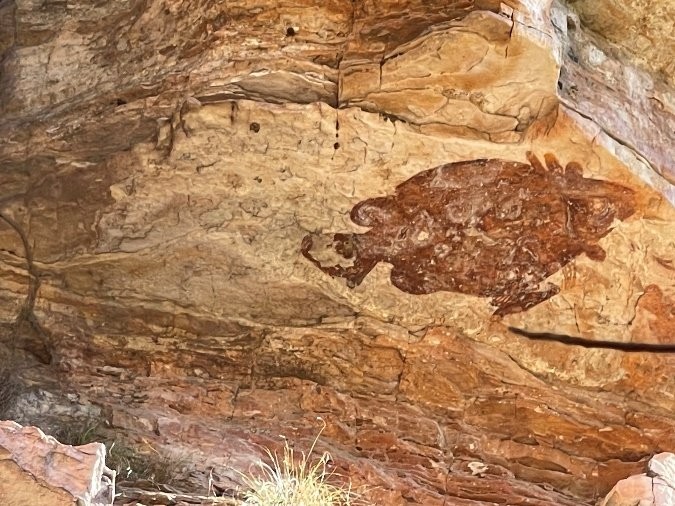
Dismantling from Wulijnmal, East Alligator River. With permission from Alfred Nayinggul.
Following extensive consultation with Njanmja and Manilikarr Traditional Owners, including senior custodians, the project has successfully established a two-way research partnership with the Manilikarr community. As a result, several promising new archaeological sites have been identified for a long-term study exploring the relationships between rock art, archaeology, and environmental change in the region. This research builds on the successful framework of the Kimberley Visions project, aiming to deepen our understanding of how people responded to changing landscapes over time. Fieldwork is scheduled to begin later this year, and we look forward to sharing further updates as the project progresses.
The Baranyi Yagu Barrabugu – Yesterday Today Tomorrow, Database
Aboriginal Heritage Office
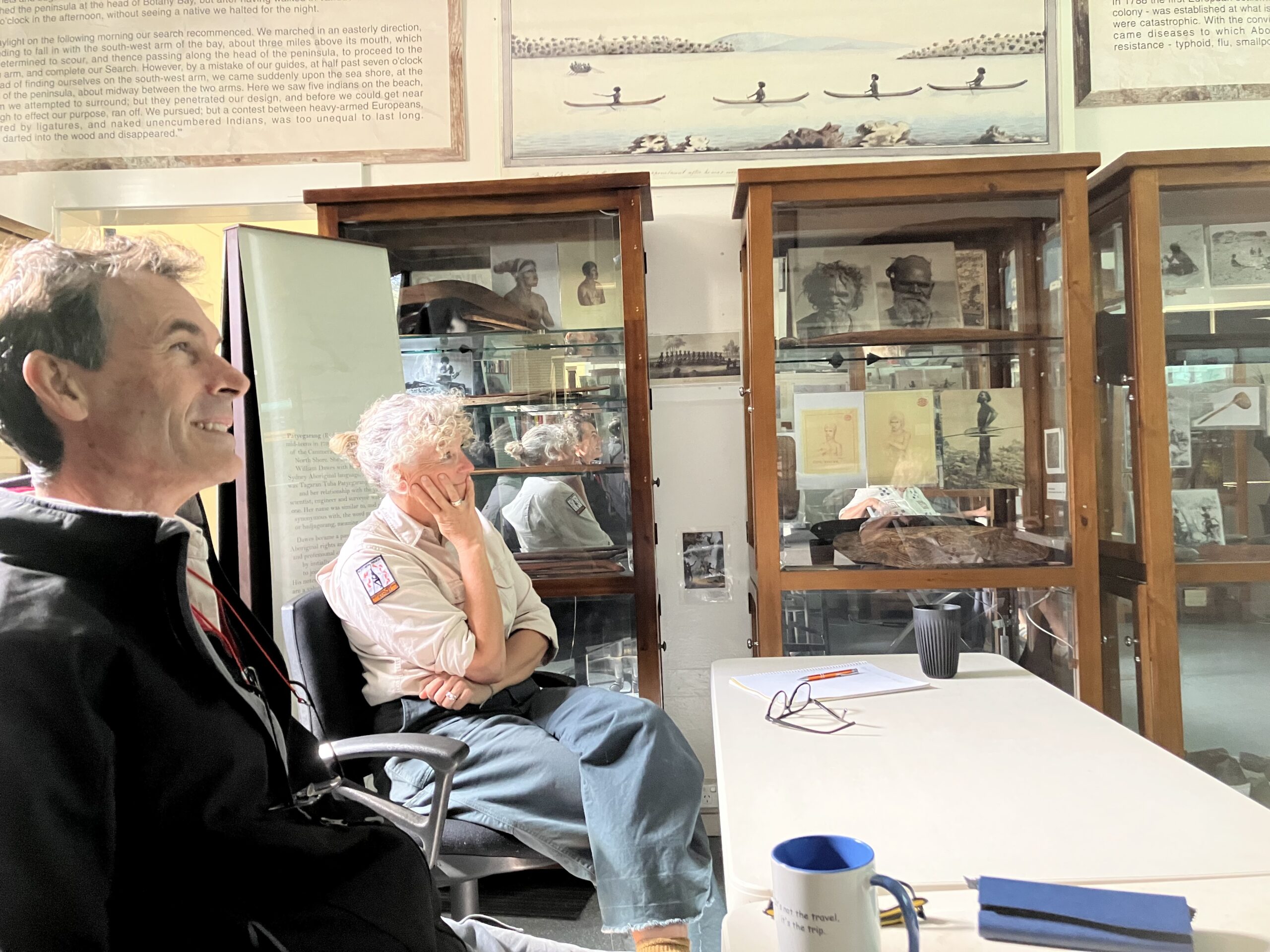
AHO’s Phil Hunt, Senior Archaeologist, & Susan Whitby, Aboriginal Heritage Officer at ABO’s HQ
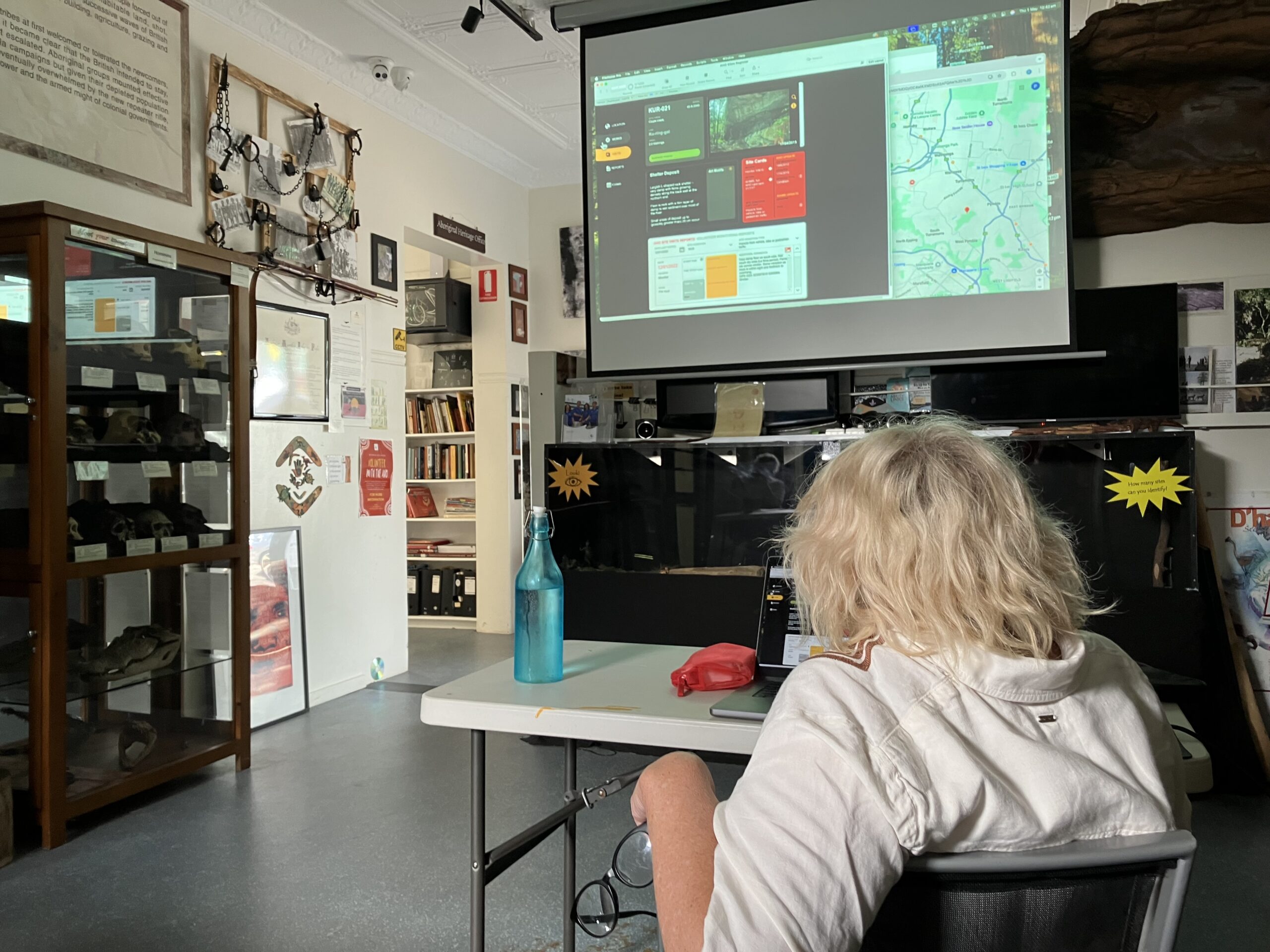
Pauline Heaney at AHO HQ in Sydney
The Aboriginal Heritage Office (AHO) was delighted to catch up with Pauline Heaney at the end of April to continue work on the AHO database. Pauline revealed the new colourful design and easy-to-use interface, which shows the AHO site cards reformatted into searchable fields, making it easier to use and providing powerful conservation functions. The mapping is simple, yet effective. The team at AHO can now create maps based on particular features, different motifs, art styles, and graffiti-affected sites. The database format also works for the Volunteer Site Monitoring Program forms, making information and images collected by AHO volunteers easily searchable.
There is still plenty of work to do preparing the legacy data. 25 years of photos takes a while to sort out! We are looking forward to the progression of this exciting project.
ARC Linkage Project: Before and after the Last Ice Age: GunaiKurnai archaeology along the Snowy (East Gippsland, Victoria)

Recording the finger grooves in the field. A (left): Madeleine Kelly checking on-site each finger groove on the photogrammetric model on a tablet. B (right): GunaiKurnai Elder Uncle Russell Mullett discussing methods and emerging results of the photogrammetric processing with Olivia Rivero Vilá and Diego Garate Maidagan in the field work tent (photos by Bruno David, courtesy of the GunaiKurnai Land and Waters Aboriginal Corporation).
We are now nine months into this 5-year project led by the GunaiKurnai Land and Waters Aboriginal Corporation with Professor Bruno David of Monash University, under the coordination of GunaiKurnai Elder Uncle Russell Mullett. The project researches the archaeology and rock art of the limestone country of the mid-Snowy River catchment area near Buchan in East Gippsland, Victoria. The study area is in Krauatungalung clan lands of GunaiKurnai Country. The project is progressing at great pace, with a number of archaeological excavations already completed or in progress. A pilot study of the Balley Hooley public campground, at the junction of the Snowy and Buchan Rivers, has revealed at least 6000 years of ancestral GunaiKurnai camping beneath today’s public campground. A new PhD student, Georgia Carra, has now enrolled at the Monash Indigenous Studies Centre, Monash University, to expand the excavation for her PhD thesis that will begin in September. A few kilometres to the north of Balley Hooley, the animal bones from seven 1 ´ 1 m squares excavated in the 1980s were analysed by Dr Matthew McDowell of the Monash team. He found the remains of six locally extinct small species including Tasmanian Devil (Sarcophilus harrisii), and of one globally extinct species, the White-footed Rabbit-rat (Conilurus albipes). The Broad-toothed Rat (Mastacomys fuscus) and Mountain Pygmy Possum (Burramys parvus), also locally extinct but found in the New Guinea II Cave bone assemblage, are restricted to alpine and sub-alpine elevations today, but here at the cave entrance they lived at 153 m above sea level, at about 500 m lower elevation than previously known from the Last Ice Age. These results are currently being written up for publication. For his PhD thesis commencing in August this year, Dylan Jenkin will be analysing the animal bones from the other squares excavated in the 1980s, plus also those from new excavations commenced inside the cave in November 2024. Those new excavations have so far reached some 70 cm depth, from which radiocarbon dates of 13,000 years have been obtained. These excavations will be continued in October this year.
Professor Jean-Jacques Delannoy, (University Savoie Mont Blanc, France) has completed a base map using terrestrial LiDAR and photogrammetry of the whole cave, and is now completing a very detailed geomorphological map of the cave. These maps are being used by all the team researchers for their various studies. Already written up and submitted for publication are a detailed recording and analysis of the finger grooves on the soft wall deep in a part of the cave beyond the reach of sunlight. A micro-photogrammetric model was constructed by Dr Olivia Rivero Vilá (University of Salamanca, Spain) and Dr Diego Garate Maidagan (University of Cantabria, Spain); from which Dr Madeleine Kelly, then at Monash, traced and analysed the grooves. The team was able to reconstruct the hand gestures of the Old Ancestors who made the finger grooves, and in one area their movements along the channel of a shallow creek bed deep in the cave could be tracked, for the ceiling overhead was marked with finger grooves as they walked. The full details of this study will be reported as soon as the scientific results have been published.
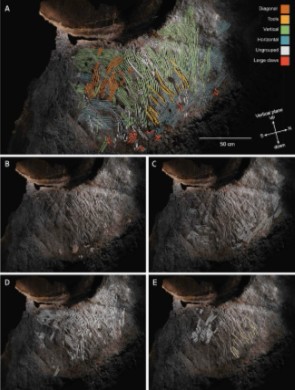
Panel 1 (left) from photogrammetric model at New Guinea II Cave, showing the superposing layers of finger flutings, tool marks and large animal claw marks (photogrammetric model by Olivia Rivero Vilá and Diego Garate Maidagan; tracings by Madeleine Kelly; courtesy of the GunaiKurnai Land and Waters Aboriginal Corporation).
On Monday July 2028, THE CONVERSATION published ‘Precious finger traces from First Nations ancestors revealed in a glittering mountain cave in Australia‘ detailing the discovery of ancient finger grooves deep within New Guinea II Cave on GunaiKurnai Country.
Inspiring the Next Generation: New School Outreach Program in the East Kimberley
Rock Art Australia is proud to support a new school outreach initiative launching in late 2025 alongside Kimberley Connections, East Kimberley College, and researchers from the University of Melbourne, the University of Western Australia and the University of Sydney.
Designed in partnership with remote schools by RAA researchers Dr Helen Green, Faris Ruzain, Dr Louise Shewan, University of Western Australia’s Dr Emily Grey, and RAA Science Advisory Council Member Dr Tristen Jones, the program aims to offer an engaging, curriculum-aligned learning experience for high school students. Through virtual reality, hands-on science, and cultural heritage activities, students will explore the deep history and enduring significance of Australian rock art.
Highlights of the Program Include:
- Virtual Country, Real Connection: Students explore 3D models of rock art sites on Balanggarra Country using VR and guided inquiry
- Recording and Conserving the Past: Archaeological activities teach students how experts document and protect cultural heritage, both in the classroom and on Country
- Rock Art and the Elements: Through interactive science experiments, students investigate how natural forces like water, fire, and geology affect pigment preservation
- Plants and Rock Art: Students learn how Traditional Ecological Knowledge informs land management and the use of native plants in fibre, paint, and cultural practices
This program will be delivered alongside community members and aligns with the Australian curriculum across science and history while fostering respect for Country, and inspiring pathways into future heritage and conservation careers.
This program is an exciting step toward inspiring the next generation to value and protect Australia’s irreplaceable rock art heritage.
The MAGNT Rock Art Digitisation Project
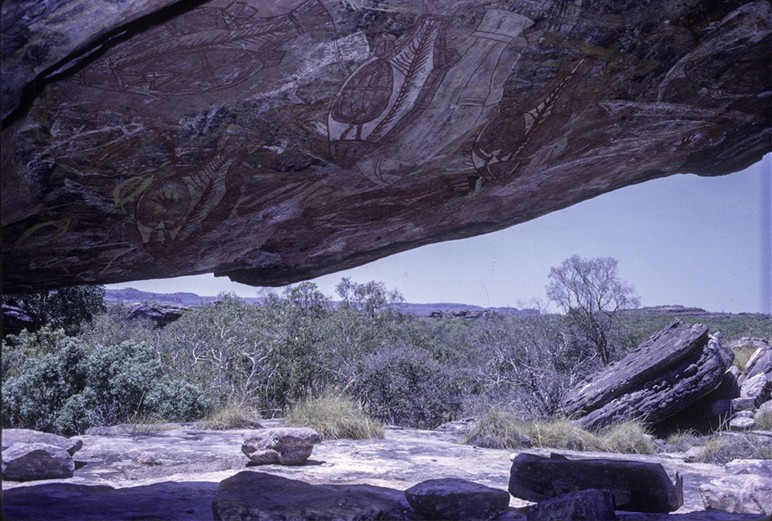
Ubirr – View from protected shelter towards the main escarpment Bunidj, Manilakarr and Mandjurlgunj caretakers Kakadu National Park (established 1979). Photograph: George Chaloupka, September 1973. Digitised courtesy of Rock Art Australia
MAGNT’s Rock Art Digitisation Project, launched in July 2023 with support from Rock Art Australia, is preserving over 22,500 rare Kodachrome transparencies from the George Chaloupka Archive, the most comprehensive visual record of culturally significant rock art sites of the Arnhem Land Plateau in the Northern Territory. Created over thirty years through a collaboration between George Chaloupka and Bininj/Mungguy Traditional Owners, this archive captures invaluable cultural knowledge. As many original rock art sites are threatened by weather and climate change, this project ensures the long-term protection and accessibility of these records, supporting Bininj/Mungguy in safeguarding their cultural heritage for future generations.
So far, around 80% of the transparencies have been successfully digitised, and verification is underway, with efforts to recreate the original order and cross-reference with available reports, maps, and site records. In addition, several thousand more colour transparencies have been discovered during the process of consolidating and relocating the collection into a culturally safe and secure space. The project has also established contact with many Traditional Owners connected to the rock art sites, with ranger groups visiting the Museum to record and protect these sites. These groups are developing their own Indigenous Cultural and Intellectual Property (ICIP) protocols. Throughout, the project remains focused on conducting the work in a culturally appropriate and safe manner, prioritising access for the relevant groups. Restrictions on outside access and use apply to all images, information, and recordings within the MAGNT Rock Art Archive.
New Publications
A new method for fingerprinting ochre sources using mineral magnetic measurements
Maddison L. Crombie, Agathe Lisé-Pronovost, Marcus J. Giansiracusa, Colette Boskovic, Amy Roberts, Felix Lauer, River Murray and Mallee Aboriginal Corporation and Rachel S. Popelka-Filcoff. Published in Journal of Archaeological Science
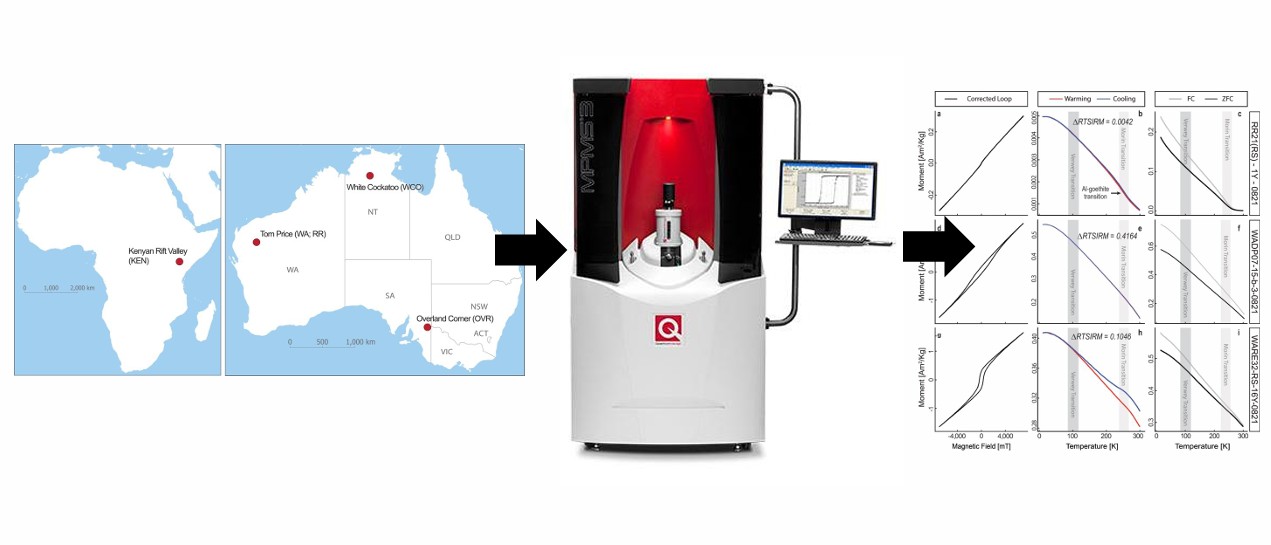
Source ochre samples were obtained from locations in Australia and Kenya. Australian ochre samples were collected from three different geographical regions: White Cockatoo, Northern Territory; Tom Price, Western Australia; and Overland Corner, South Australia. The graphic shows different magnetic behavior of rock samples from Tom Price, Western Australia, used to understand the types of iron minerals in ochre and their provenance.
PhD student Maddison Crombie in the Archaeological Science Laboratory at the University of Melbourne recently published novel research on the non-destructive provenance analysis of ochre by magnetic measurements. The paper, published in the Journal of Archaeological Science, introduces an exciting approach to tracing the movement of ochre’s iron-rich natural pigments across landscapes. By applying advanced magnetic analytical methods, the research demonstrates how unique magnetic signatures can be used to “fingerprint” ochre sources, offering fresh insights into past cultural exchanges. The study showcases the potential of techniques such as isothermal remanent magnetisation and hysteresis measurements to distinguish between geological contexts, paving the way for new discoveries in archaeology and the study of ancient exchange networks. Maddison is supervised by Professor Rachel Popelka-Filcoff.
This manuscript is an outcome from ARC DP DP190102219 Ochre Archaeomicrobiology: A New Tool for Understanding Aboriginal Exchange, a project led by Rachel Popelka-Filcoff, (University of Melbourne), in collaboration with Claire Lenehan, Amy Roberts, Claire Smith and Robert Edwards (Flinders University), Shane Tobe (Murdoch University), and four Indigenous partner organisations: River Murray and Mallee Aboriginal Corporation, Barunga Community, Yinhawangka Aboriginal Corporation and Wintawari Guruma Aboriginal Corporation.
Insights into the terminal Pleistocene climate of Australia from high-resolution climate modelling
Andrew L. Lowry & Hamish A. McGowan. Published in nature.
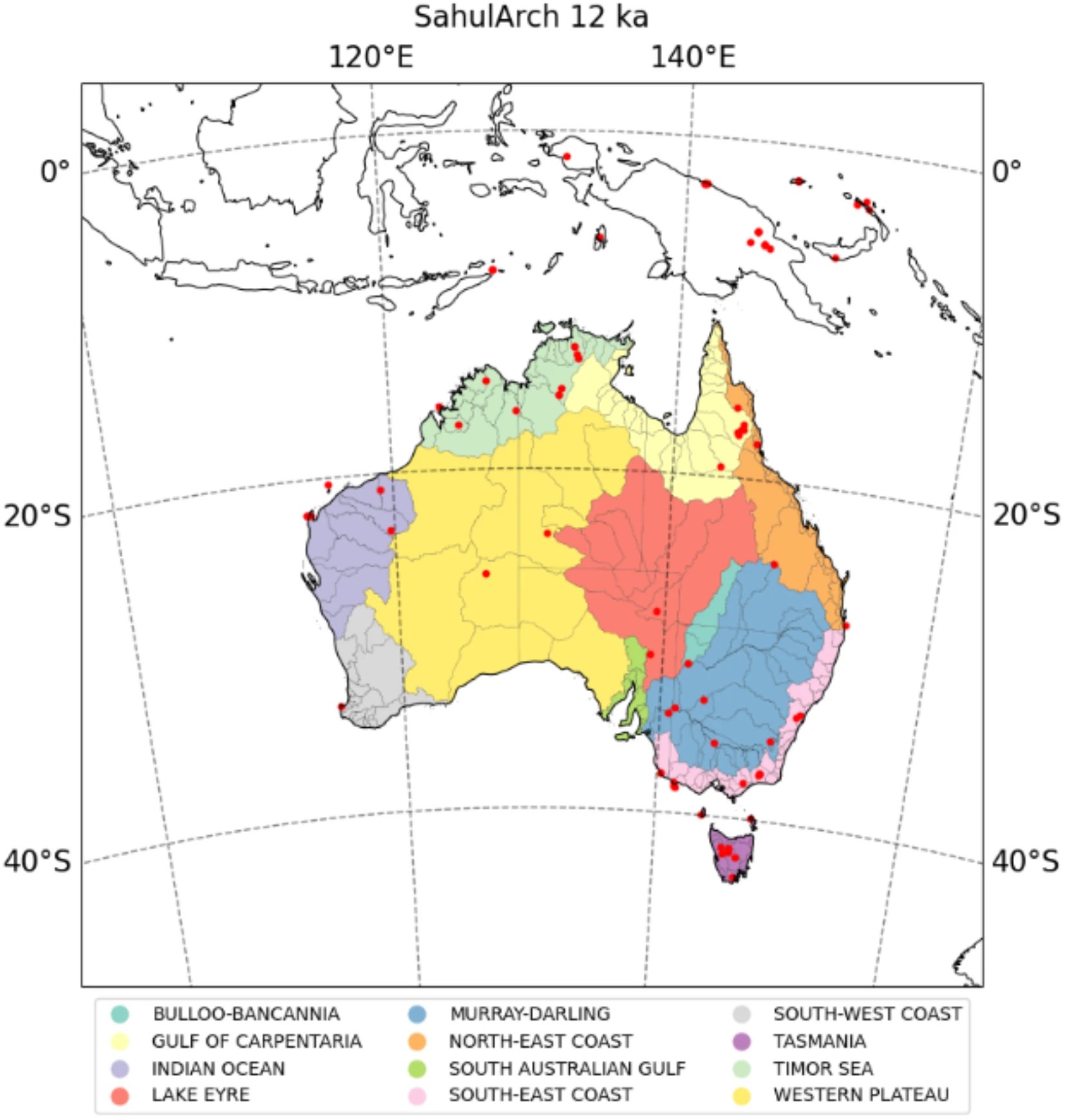
Locations of archaeological sites from the SahulArch database50 with an occupation date between 11.5–12.5 ka (red dots). The major drainage basins of modern-day Australia are shown underneath, including the sub-basin margins and modern-day state boundaries in grey lines.
This pioneering study sheds new light on Australia’s climate at the end of the last Ice Age. Leveraging high-resolution climate modelling, this research provides the most detailed reconstruction yet of the terminal Pleistocene environment across Sahul–Australia, around 12,000 years ago. Using advanced downscaling techniques, the study reveals nuanced changes in temperature and monsoon activity that shaped the lives of early Aboriginal populations.
By pinpointing key meteorological features and climatic shifts, this work offers invaluable insights into how ancient communities adapted to a rapidly changing world—opening new avenues for understanding Australia’s deep past.
Events, trends and the ‘Pompeii Premise’: Telling stories of the Old Ancestors in Australian archaeology
Bruno David, Jessie Birkett-Rees, Ashleigh J. Rogers, Fiona Petchey, Amy Mosig Way, Russell Mullett, Joanna Fresløv, Augustine Unghangho, Ian Waina, Jean-Jacques Delannoy & GunaiKurnai Land and Waters Aboriginal Corporation. Published in Australian Archaeology.
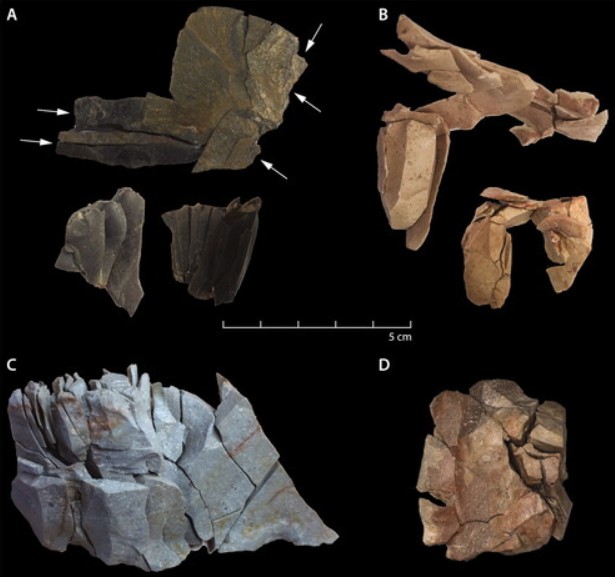
Examples of stone artefact conjoin sets indicative of individual events, from Weereewaa (Lake George), in Ngunnawal, Ngarigo and Ngambri Country.
The paper re-examines how Australian archaeology tells the stories of the Old Ancestors. While most research has focused on long-term trends, this study highlights the value and responsibility of investigating short-term events preserved in the archaeological record. By revisiting the influential ‘Pompeii Premise’ debates, the authors advocate for refined excavation methods that capture the fleeting moments of the past. This paper calls on archaeologists to observe the traces of ancient lives more closely, enriching our understanding of Australia’s deep history through the stories held in buried deposits.
Apply for Rock Art Research Funding
At Rock Art Australia, we bring scientific research and Aboriginal cultural knowledge together to study rock art provinces of Australia. We study them to understand the history of Aboriginal Australia and its significance in the global narrative of human origins and to ensure its protection.
We initiate and support integrated, multi-disciplinary scientific research which is co-developed with Aboriginal communities to ensure it meets the needs for the Aboriginal people of the region. We actively foster engagement with Country and culture.
To learn more about Rock Art Australia’s research priorities and how to apply for RAA research funding, please visit our website by clicking the link below.
For general enquiries please contact: grants@rockartaustralia.org.au
Events
Past Events | Two Ways: A Rock Art Research Journey Lecture Tour
Two Ways: A Rock Art Research Journey Lecture Tour
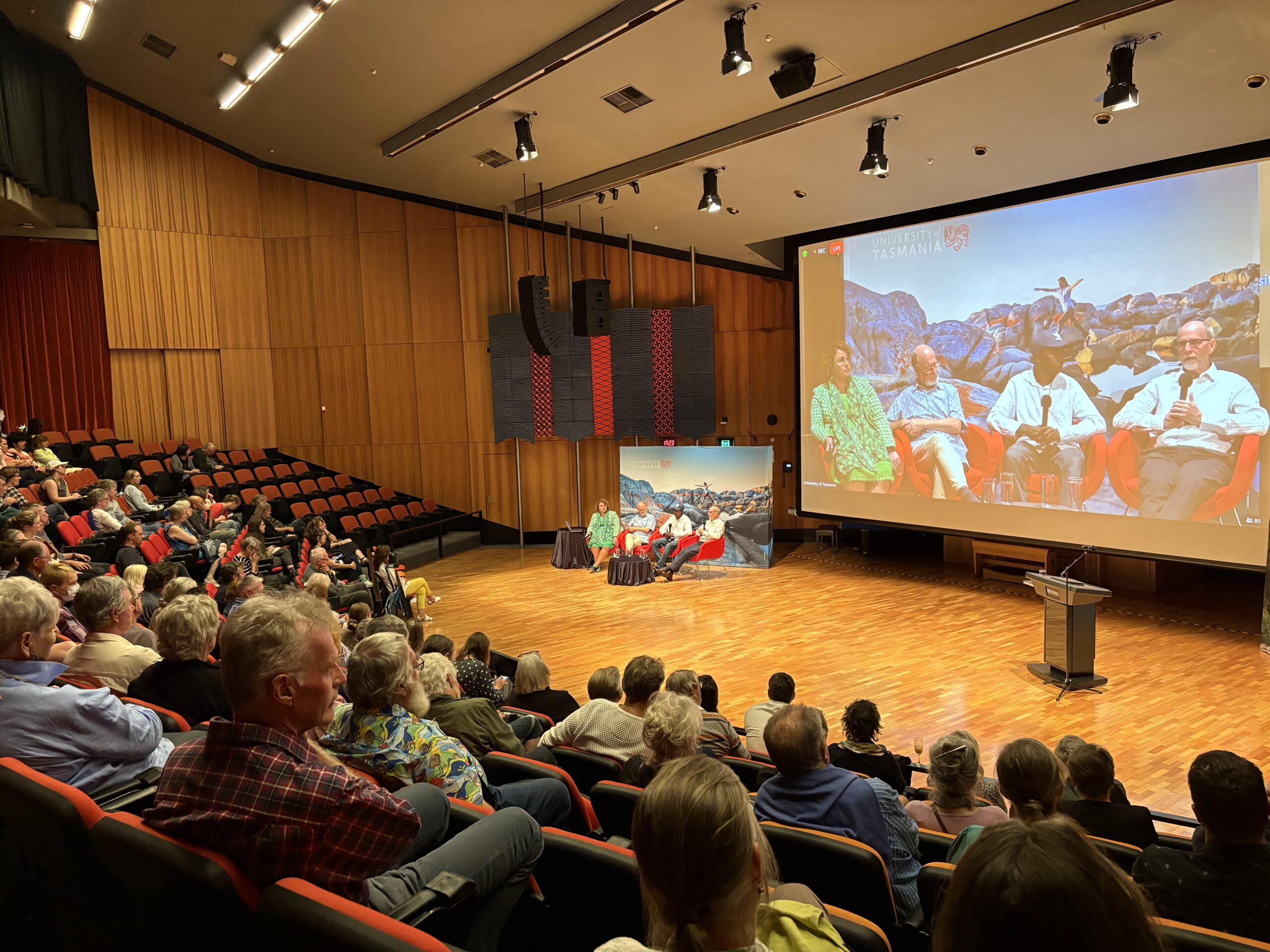
The national tour of Two Ways to See: A Rock Art Research Journey concluded in March with our final lectures in Canberra and Hobart.
We are deeply grateful to the more than1,000 people who joined us across seven cities, both in person and online, and extend our heartfelt thanks to our generous donors, whose support made the tour possible, and to our valued partners who provided venues, volunteers, and essential local support. These partnerships are instrumental in supporting our mission to share the powerful stories and insights from our collaborative rock art research with as many people as possible, sharing facts that all Australians should know about our rich history.
A special thank you to the University of Tasmania for hosting the Hobart lecture, which was streamed live and recorded as part of the 2025 Island of Ideas Public Talks series. Please view this lecture through the below link.
To celebrate the conclusion of Two Ways to See: A Rock Art Research Journey, co-presenters Ian Waina and Andy Gleadow took time to reflect on their experience. They contemplate the impact of the lecture series, what it meant to share this journey with diverse audiences across the country, and their hopes for the future of two-way research.
Ian Waina’s deep involvement in the Kimberley rock art dating project has been transformative. His commitment to a two-way approach, integrating Aboriginal cultural perspectives with academic research, led to the 2023 publication of Two Ways to See: A Rock Art Research Journey. This collaborative book arose from the many questions Ian encountered during fieldwork and from his desire to better understand the deep-time history of his ancestors while sharing that learning widely. The book weaves together Traditional Owner insights, scientific research, and creative expression, including a poem by Kwini Elder Ambrose Mungala Chalarimer, to reflect Ian’s idea of “the two ways to see”: one cultural, one scientific.
As Ian reflects:
“I see the rock paintings as mine and my people’s legacy, our diary, our libraries, our cultural institutions, if you like. Working with scientists and seeing the art from both sides has been so important. That’s why I wanted to publish the book and speak on the national lecture tour with Andy. I want the world to know about the paintings, and one day, I want to learn about rock art from other countries, in other parts of the world, to see what their old ancestors had to say”.
For the full Q&A with Professor Andy Gleadow, and how to purchase a copy of Two Ways to See, click the link below.
Coming Up
Film Screenings 2025 | Two Ways: The Kimberley Rock Art Legacy
Building on the momentum of the lecture tour, we are excited to announce the next phase of this journey: a national film screening tour of Two Ways: The Kimberley Rock Art Legacy. This documentary brings the research and stories to life through powerful visuals and voices from the field.
Earlier this year, we hosted a special advance screening for Year 7 and 8 students from the Melbourne Indigenous Transition School (MITS) at Trinity Grammar in Melbourne. Presented by RAA CEO Dr Samantha Hamilton and Dr Damien Finch from the University of Melbourne, the screening was met with enthusiasm and thoughtful engagement. The students shared valuable feedback and ideas for how the film could reach broader audiences across Australia. Their response was very encouraging, and it influenced us to bring Two Ways to communities nationwide.
Stay tuned, screening dates and locations Australia-wide will be announced soon.
Every Contribution Helps Tell a Deeper Story
Thank you for taking the time to explore just a few of the extraordinary projects your support makes possible. Behind every discovery, publication, school visit, and cultural preservation effort is a partnership between researchers, Traditional Owners, communities, donors and supporters like you.
The knowledge we uncover today will shape how future generations understand Australia’s rich and complex history. But this work requires sustained funding, deep collaboration, and long-term vision.
As we near the end of the financial year, your tax-deductible donation can make a lasting impact, advancing multidisciplinary and two-way research, supporting meaningful community engagement, and ensuring that Australia’s rock art and cultural heritage continue to be preserved, protected and shared.
Please consider donating today. Together, we can foster a stronger, more united national identity grounded in knowledge and respect. Our research will provide the foundation for all Australians to unite with pride in Australia’s deep and enduring human story.

